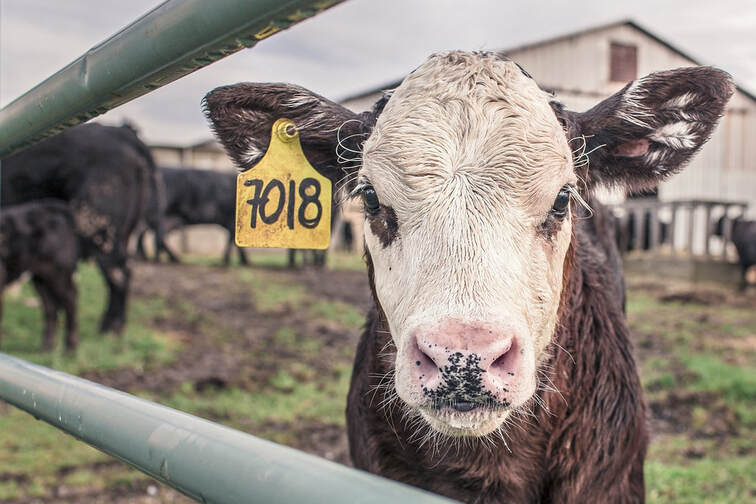|
The price of your favorite breakfast beverage doesn’t seem to be falling anytime soon.
Click here to read the full article.
0 Comments
Not many ranchers active today will remember the last time the U.S. cattle industry was this small. On January 1, 2024, the All Cattle and Calves inventory was 87.15 million head, the smallest total inventory since 1951. The All Cattle and Calves inventory is 1.9% smaller year over year and is the fifth consecutive year of declining cattle inventories, a total decrease of 7.65 million head or 8.1% since the most recent peak in 2019. The 2023 calf crop was 33.6 million head, down 2.5% year over year and the smallest calf crop since 2014.
Click here to read the full article. Last year, an unusually low orange yield in Florida drove the costs of orange juice to record-breaking highs — and there are fears those trends could continue, but the U.S. Department of Agriculture is optimistic for a rebound in 2024.
Click here to read the full article. Orange juice futures are hitting record highs. Here’s why, and what it means for consumers8/14/2023 Orange juice futures are hitting record highs because of bad weather and a nasty citrus disease. That could mean higher prices at the grocery store. In recent weeks, prices in the OJ futures market have topped $3 per pound. Around this time last year, prices were hovering at around $1.81 per pound. The price increase has been fueled primarily by short citrus supply around the globe.
Click here to read more. FLAKY, GOLDEN PERFECTION IN A FRACTION OF THE TIME
There’s no thawing. No proofing. No preparation stress. Just delicious, flaky, fresh Pillsbury croissants every single time. Croissants are delicious on their own, but they’re also the perfect canvas for culinary creativity! Get started with a free recipe book filled with 12 irresistible recipes your customers will love — from Orange Almond Croissant Sticky Buns to Steak Frites Croissants with Blue Cheese Crumbles. Check out General Mills Croissant Recipe Book! Kraft Heinz Taste & Trends - July 2023 The first thing that comes to mind when people hear the word HEINZ is ketchup. No surprise there. These days global flavor trends and people’s hunger for new and unique experiences has given rise to some new and innovative sauce combinations made by HEINZ.
Click here to read the full article. Irked by California’s Proposition 12, seven farm-state senators announced legislation on Thursday to prohibit states from regulating agricultural production in other states. Virtually anyone — producer, distributor, trade group, transporter, consumer, and laborer were named in the bill — would be empowered to challenge such regulatory infringement in court and seek financial compensation.
Click here to read the article. In 2020, at the onset of the COVID-19 pandemic, the leisure and hospitality industry in the United States suffered more job losses than any other sector. The majority of layoffs were in foodservice, with around 5.5 million chefs, waiters, and cashiers forced out of their jobs.
As restaurants continue to recover, the main focus is on attracting customers while keeping costs down. However, the widespread labor shortage in the United States is making it difficult for foodservice companies to thrive and meet all-important revenue targets. The shortage is having a significant impact from small towns to major foodie cities including Orlando, New Orleans, and San Francisco. Click here to read the full article. The worst-ever outbreak of highly pathogenic avian influenza continued, with the virus affecting flocks in the U.S. and abroad.
United States On Feb. 21, the USDA's Animal and Plant Health Inspection Service announced an HPAI outbreak in a commercial broiler production flock in Lancaster County, Pa. The USDA stated that 97,700 birds were affected, and the outbreak is still considered active. That is the third commercial broiler outbreak so far in 2023. On Jan. 20, a detection in Weakley County, Tenn. affected 267,800 birds, and a Feb. 7 outbreak in Leake County, Miss. affected 89,800 birds. Canada Like the U.S., Canada is also grappling with historic HPAI outbreaks. According to the Canadian Food Inspection Agency, approximately 7.2 million domestic birds in Canada have been affected in the last year, with 3.7 million cullings in British Columbia alone. The Globe and Mail notes that more than $82 million has been paid, to date, as compensation for cullings. South America, Caribbean cases HPAI was recently declared "endemic" by world health experts, and the virus has continued its spread to other countries. In the last week, both Argentina and Uruguay confirmed their first cases among wild birds, according to Poultry World. Currently, Brazil, Guyana, and Suriname are the only South American countries without detections. Argentina’s secretary of Agriculture, Livestock and Fisheries, Juan José Bahillo, blamed migratory birds for the country's detection; the secretary called an emergency meeting to address matters. Additionally, WATT cited WOAH reports that three birds at Cuba's Jardín Zoológico de La Habana zoo in Havana died from HPAI. The detection resulted in the culling of 82 birds in the zoo's area. Positive customer engagement can build long-lasting connections between customers and your brand. However, if you're not doing it right, customers will disengage, negatively affecting your overall revenue. Click here to read the full article.
The burgeoning influence of Generation Alpha, whose oldest members will start hitting their teens this year, will have a growing effect on food trends in the coming years, Datassential's Samantha Des Jardins writes. Other factors expected to drive food trends in 2023 include artificial intelligence, greater risk-taking with menus, and a broadening of the definition of "third place" as more people shift to working from home.
Datassential, the leading food and beverage insights platform connecting the dots between consumers and the food industry, has unveiled the tentpole themes and macro trends that will impact the food industry in the coming year. Click here to read the full article. Higher ingredient costs will continue to plague restaurant operators in 2023, forcing them to streamline menus, according to several foodservice industry experts. Click here to read more.
Historic storms have hammered California for more than two weeks, causing widespread flooding, road closures, power outages and evacuations in numerous counties.
As the state received roughly five times its average rainfall, the deluge offered water relief for drought-stricken farmlands. But the storms also inflicted a harsh toll on agriculture. Click here to read the full article. Even with eggs in short supply nationwide and prices climbing to new heights, it has not been enough to keep a 100-year-old egg farm from going out of business.
John Lewis Jr., president of Farmer John Egg Farm in Bakersfield, confirmed that the family operation will close its doors by the end of the month. The move comes as commercial poultry farms across the country have been pummeled by avian influenza, which has led to bird losses topping 57 million and shoppers facing sticker shock on eggs. Click here to read the full article. The avian flu is hammering U.S. poultry farmers, leaving experts to ask: What has changed?1/25/2023 The worst outbreak of avian influenza on record is threatening to stretch into a second year, as the U.S. races to contain a virus that has already caused some food prices to soar amid a shortage of eggs.
Nearly 58 million birds from commercial and backyard flocks have been wiped out in the U.S. since last February, according to the U.S. Department of Agriculture’s Animal and Plant Health Inspection Service. Click here to read the full article. High prices are driving an increase in attempts to bring eggs into the US from Mexico, according to border officials. Officers at the San Diego Customs and Border Protection Office have seen an increase in the number of attempts to move eggs across the US-Mexico border, according to a tweet from director of field operations Jennifer De La O. Click here to read the full article.
If the flavors have felt slightly off at your favorite restaurant lately, it may not be your imagination. An eye-opening new report on the state of the restaurant industry entering 2023 reveals economics have started influencing ingredients in a major way. Click here to read the full article.
As the U.S. poultry industry continues to contend with the nation’s worst outbreak of highly pathogenic avian influenza (HPAI) ever, experts are weighing in on the difficulties of trying to contain the bird-killing virus.
“This is the largest animal emergency that the USDA has faced in this country,” Gino Lorenzoni, an assistant professor of poultry science and avian health at Pennsylvania State University, told NBC News. Efforts to prevent infections in commercial and backyard flocks are particularly difficult in that HPAI infections can come from wild birds. In addition to direct exposure, fecal matter can contaminate the grounds around farms and yards, the story published Thursday noted. The USDA on Thursday announced a notice of intent to prepare an environmental impact statement for HPAI in the U.S., with the agency’s Animal and Plant Health Inspection Service (APHIS) requesting public comment to define its scope. The agency said it would consider all comments received on or before Feb. 17. As of Thursday, the government’s tally included confirmed HPAI infections in 732 commercial and backyard flocks, affecting 57.87 million birds since February 2022. The latest infection was confirmed Wednesday in Lampasas County, Texas, according to APHIS. Chickens may not be able to fly very far, but the price of eggs is soaring. A lingering bird flu outbreak, combined with soaring feed, fuel and labor costs, has led to U.S. egg prices more than doubling over the past year, and hatched a lot of sticker shock on grocery aisles. Click here to read the full article.
Americans consume several billion pizzas each year. More than eight in 10 consumers eat pizza at least once a month, and about half of them are slicing a pie once a week, according to Technomic research. Pizza clearly is one of America’s favorite go-to comfort foods. Click here to read more.
The number of U.S. restaurants — including chain franchises and independents — is still meaningfully lower than what it was before the advent of COVID-19. Click here to read the full article.
Here’s a sobering statistic: Even if every single unemployed person in the country takes a job, there would still be more than 5 million unfilled positions according to the U.S. Bureau of Labor Statistics. The foodservice industry, a bit of a jobs powerhouse with a corps of nearly 15 million workers, has historically high turnover rates, a situation further complicated by the tight, post-pandemic jobs market. Click here to read the full article.
Highly pathogenic avian influenza continued its destruction of U.S. commercial and backyard flocks in the final days of 2022. The latest tally from the USDA’s Animal and Plant Health Inspection Service had five outbreaks confirmed last week in four states: Kansas, Michigan, Tennessee and Washington.
The largest recent outbreaks involve two commercial broiler breeder producers in Tennessee’s Weakley County, and affected a total of 62,600 birds between them. Confirmed HPAI detections in 2022 include 306 commercial and 411 backyard flocks in 47 states, affecting 57.82 million birds, the federal agency said Wednesday in its last update. According to APHIS, commercial and backyard flocks in just three states — Hawaii, Louisiana and West Virginia — have been spared amidst the deadliest HPAI outbreak in U.S. history. The last major HPAI outbreak in the U.S. occurred in 2015, when 50.5 million chickens and turkeys perished. The ongoing scourge of HPAI is a global issue, with Japan and the Czech Republic among the nations reporting massive culling efforts in recent weeks. Outbreaks were also reported in Mexico and Canada during the month of December. William W. Wilson, an expert in risk management and trading at North Dakota State University, predicted increased volatility in the U.S. grain market throughout 2023.
Part of the reason commodity prices rose so sharply, Wilson explained, is transportation rates are much higher for alternative grain shipping routes out of Ukraine, according to a report in Feed & Grain. Rail routes that traditionally went to Odessa now route through Romania, Poland and Moldova, which adds as much as $125/metric tonne to costs. “Unblocking exports by sea will significantly strengthen the stability of the economy and alleviate the acuteness of the food crisis, but only under the condition of stable export of six million tonnes of grain per month at least until March 2023,” Wilson said. Rising grain prices due to both the war in Ukraine and disappointing harvests in the US, Europe and Asia, are compounding challenges producers already face from global supply chain disruptions and labor and energy costs. Wilson, who studies grain marketing as well as logistics and supply chain systems, offered his comments during the closing general session of the National Grain and Feed Association’s 2022 Country Elevator Conference in December 2022. |
AuthorWrite something about yourself. No need to be fancy, just an overview. Archives
June 2026
Categories
All
|












 RSS Feed
RSS Feed